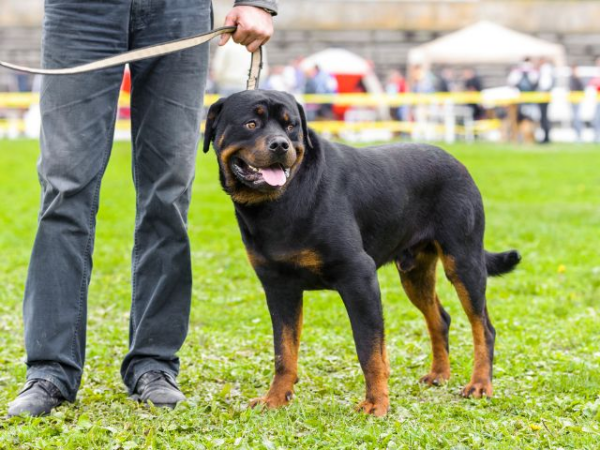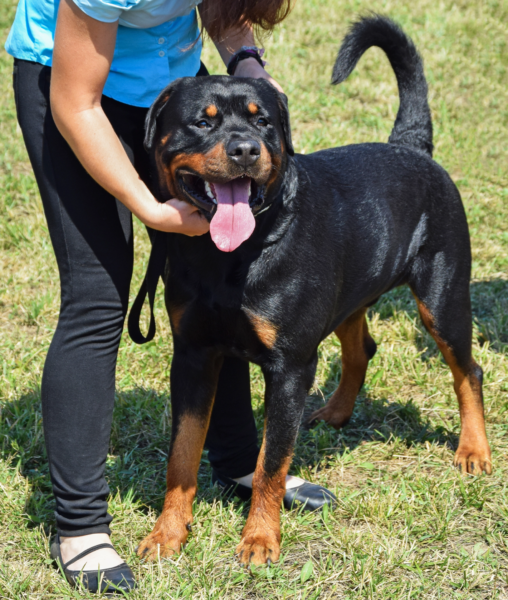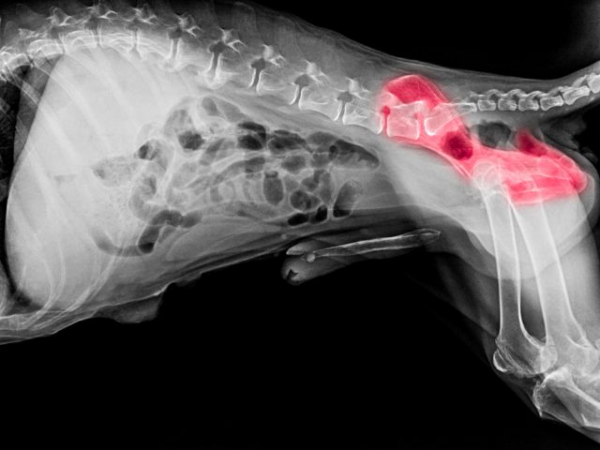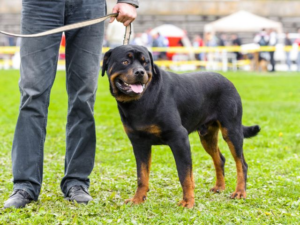Progressive retinal atrophy (PRA) in dogs is not actually one single condition, but rather is an umbrella term used to describe a group of genetic diseases that affect the cells of the retina. [1] As a brief anatomy reminder, the retina is the layer at the back of our eyes which contains rod and cone cells, and which allows us to see.
Whilst the specific conditions within the PRA “group” vary from each other quite a bit in terms of what’s going on at a cellular level, as far as pet parents are concerned it’s both fair and practical to consider all of these conditions pretty much the same thing.
One very important thing that all cases of PRA have in common is in every case the dog is either known (in some cases) or suspected (in others) to have inherited the condition from both parents. That’s right: both parents must carry the faulty gene in order for there to be a chance that the offspring is affected.
The other crucial thing to know about progressive retinal atrophy is that heartbreakingly the disease gets worse over time, and will eventually lead to blindness, plus or minus a few other unpleasant complications such as glaucoma.
If you are interested in finding out more about Rottweiler common health problems, read here.
Read here about cropping Rottweiler ears.

How Does Progressive Retinal Atrophy Happen?
Because PRA describes a group of conditions rather than one single entity, it’s convoluted (and frankly a little more complex than is necessary) to describe exactly how the disease occurs. The key, overarching point however, is that the rod and cone cells of the retina are affected, eventually leading to blindness in the affected individual. Both eyes are always affected.
The retina eventually becomes atrophied (kind of like, withered away) and the nerve cells that are supposed to conduct input from the retina to the brain via the optic nerve become scarred. Progressive retinal atrophy can also result in complications additional to blindness, such as retinal detachment, cataracts and painful glaucoma. [1]
Which Dog Breeds are Prone to PRA?
As we already mentioned, progressive retinal atrophy is an inherited condition and therefore it logically follows (and has been proven by copious scientific research) that some dog breeds are more likely than others to fall prey to the disease. Members of the following breeds are known to have a greater likelihood of developing PRA:
- Rottweiler
- Bedlington Terrier
- Cavalier King Charles Spaniel
- American Cocker Spaniels
- English Springer Spaniels [2]
- Spitz (Kelawala)
- Labrador and Golden Retrievers
- Tibetan Terrier and Tibetan Spaniel
- Dachshund
- Papillon
- Miniature Schnauzer
- Australian Cattle Dog [3]
What are the Early Signs of Progressive Retinal Atrophy in Rottweilers?
Most (but not all) of the conditions that cause PRA will hit the rod cells of the retina first. Since our rods are most important for night vision, poor eyesight at night or “night blindness” is often the first sign that is noticed when a Rottweiler develops progressive retinal atrophy. [1]
Pet parents may also notice that their Rottie behaved less confidently than they used to at dusk and dawn (ie, in low light levels), or that he or she has started to actively seek out lights when it’s dim. [3]

What Age Does PRA Start in Rottweilers?
If you’ve been paying attention, you know by now that progressive retinal atrophy is a group of conditions. However, it’s also worth being aware that all of these conditions fit into one of two main categories or “forms” of PRA: specifically, an early onset form that tends to be diagnosed in young puppies aged 2-3 months old, and a late-onset form that affects adult dogs aged between 3 and 9 years. [2]
In one study of 31 dogs who were suspected to have PRA, 26% (8 dogs) were between 1-5 years of age, 48% (15 dogs) were 6-10 years of age and the rest (26%) were 11 years or older. These findings suggest that it may also be possible for PRA to develop after the 9 year mark. [4]
You might also hear the early onset form of the disease referred to as retinal dysplasia. “Dysplasia” refers to the fact that the retina doesn’t ever really develop normally to begin with, in these young dogs. Unfortunately, Rottweilers can be affected by either form of PRA, meaning they may be diagnosed as young as a couple of months old, or years later in life.
What is the Prognosis of PRA in Rottweilers?
The sad fact is that progressive retinal atrophy eventually leads to blindness in all cases, so if your Rottweiler has been diagnosed with PRA you should begin practically and emotionally preparing for him or her to gradually develop complete vision loss. The good news is that most dogs adapt very well to blindness, especially when this develops slowly (like in PRA).
As a veterinarian, I can report that there are many PRA sufferers out there happily living their doggy lives without too much care for the fact that they can’t see. See the subheading directly below to learn what you can do as a pet owner to help your Rottie if they are affected.

How Does PRA Affect My Rottweiler?
If your Rottweiler has been diagnosed with progressive retinal atrophy, you need to start arming yourself with the knowledge and tools you will need in order to provide a comfortable life for him or her once the disease ultimately culminates in vision loss. The silver lining is that so long as complications such as glaucoma don’t also develop, PRA is not a painful condition.
Preparations include making sure there are no hazards around your home such as “pointy bits” or an uncovered swimming pool. It’s also very sensible to plan on staying in one place for your Rottie’s sake, as your pet will have learned where everything is in his or her home and (so long as you don’t move things about) they’ll continue to be able to find everything they need without much difficulty. Moving homes with a blind pet can be a disastrous upheaval; avoid at all costs.
Contrary to popular belief, many dogs with PRA will still enjoy all manner of daily activities such as cuddling with owners, sniffing out treats, and even going for walks! Don’t forget, your Rottweiler relies much more on their hearing and sense of smell compared to you when it comes to maneuvering about their day-to-day life.
Still, every little helps: I recommend that you purchase a “halo” for your Rottweiler in advance and get him or her used to wearing it ready for when this is a necessary addition to walkies.
How Long Does it Take for a Rottweiler with PRA to Go Blind?
The exact length of time that it takes for a Rottweiler with progressive retinal atrophy to go blind varies quite significantly. Generally, Rotties will experience poor night vision for a period of between 6 months and 3 years prior to the eventual complete loss of all vision.
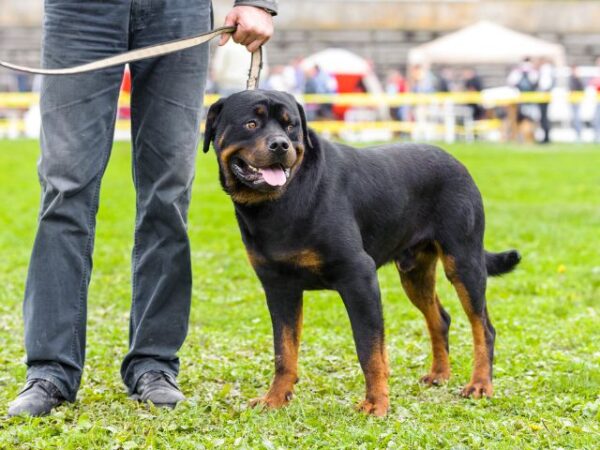
What Does PRA Look Like in Rottweilers?
Night blindness is typically the first sign that Rottie owners will notice if their dog is developing progressive retinal atrophy. This poorer-than-usual night vision sticks around for 6-36 months before daytime vision is also eventually lost.
Whilst the condition does sadly culminate in blindness, it’s reassuring to many Rottweiler owners to know that PRA is not a painful condition, so long as glaucoma does not develop as a complication.
How Do You Treat Progressive Retinal Atrophy in Rottweilers?
Whilst the treatment of progressive retinal atrophy is currently an active area of veterinary research, as it stands there is no effective treatment for progressive retinal atrophy in Rottweilers, or any other dog breed for that matter. If your Rottie has been diagnosed with PRA I strongly recommend you visit the subsection above titled “How Does PRA Affect My Rottweiler?” to learn what you can do to help your dog adjust well to a life without sight.

What Supplements are Good for Dogs with Retinal Atrophy?
It’s important to be realistic about the fact that there is no known effective treatment for progressive retinal atrophy, and that affected dogs will ultimately go blind.
However, so long as realistic expectations are maintained and the necessary preparations are made to help the dog continue to live a good life once vision is lost, then there is likely no harm in feeding a good quality supplement to support retinal health as much as possible.
Some research findings even suggest that certain supplements may be able to slow the progression of the condition. Supplementation of the following compounds (in quantities advised by your dog’s own vet, based on his or her weight) may be beneficial:
- Alpha-lipoic acid
- Beta-glucan
- Coenzyme Q10
- Green tea extract
- Lutein
- Lycopene
- Omega-3 fatty acids
- Vitamin B1 (thiamin)
- Vitamin B3 (niacin)
- Vitamin B5 (pantothenic acid)
- Vitamin B7 (biotin)
- Vitamin B9 (folate)
- Vitamin C
- Vitamin E
Do keep in mind of course that the above are not a valid substitute for feeding a complete and balanced diet as directed by your Rottie’s own veterinary dog-tor. As a general rule in my experience, the better a dog’s diet and overall wellbeing, the more slowly degenerative conditions such as PRA tend to progress.
References
- Labelle, P. (2017) ‘Canine Progressive Retinal Atrophy’, Pathologic Basis of Veterinary Diseases (Sixth Edition).
- Hunter, Llera, R. and Yuill, C. (2023) ‘Progressive Retinal Atrophy in Dogs’, VCA Animal Hospitals.
- O’Reilly, and Hardman, C. (2024) ‘Progressive Retinal Atrophy (PRA)’, Melbourne Eye Vet.
- Kelawala, N., Patil, D.B., Parikh, P.V., Sheth, M.J., Joshi, C.G. and Reddy, (2017) ‘Clinical studies on progressive retinal atrophy in 31 dogs’, Iranian Journal of Veterinary Research, 18(2), pp. 119-123.


